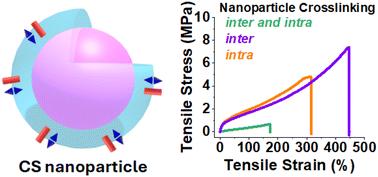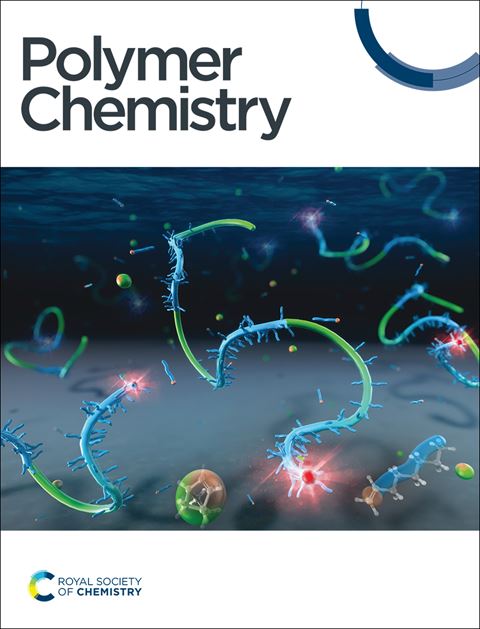Converting high modulus water-based elastomeric core–shell nanoparticle films from viscoelastic to predominantly elastic using di-epoxide crosslinking†
IF 3.9
2区 化学
Q2 POLYMER SCIENCE
引用次数: 0
Abstract
Most elastomers are formed using solvent-based processes which result in an environmental burden. Consequently, elastomers formed using water-based nanoparticle dispersions are highly desirable. Here, we investigate elastomer-like films based on water-dispersible carboxylic acid-containing core–shell (CS) nanoparticles. The nanoparticles contain a poly(n-butylacrylate) (PBA) core and a poly(BA-co-acrylonitrile-co-methacrylic acid) shell. We react the –COOH groups of the shell with a di-epoxide (1,4-butanediol diglycidyl ether, BDDE) which replaces dissipative hydrogen bonds in the nanoparticle elastomer films with covalent bonds. The reaction with BDDE enables the transformation of a stretchable dissipative film (shear modulus of 9.0 MPa with 20% strain energy recovery) into a predominantly elastic film (shear modulus of 0.20 MPa with almost 100% energy recovery). Our optimum system, CS-0.5, has a shear modulus of 0.40 MPa, an impressive strain-at-break of greater than 300% and an energy recovery of 80%. The strain-at-break is increased to more than 450% using a monofunctional epoxide. We further explore the inter- and intra-nanoparticle nature of the di-epoxide reaction and how the mechanical properties can be tuned by varying the method of film formation. The facile approach introduced here enables the tuning of the mechanical properties of elastomeric core–shell nanoparticle films from dissipative to predominantly elastic on demand.


利用二环氧化物交联将高模量水基弹性体核壳纳米颗粒薄膜从粘弹性转化为主要弹性
大多数弹性体是使用溶剂型工艺形成的,这对环境造成了负担。因此,使用水基纳米颗粒分散体形成的弹性体是非常理想的。在这里,我们研究了基于水分散的含羧酸核壳纳米粒子的类弹性体薄膜。纳米颗粒含有聚(正丁基丙烯酸酯)(PBA)核和聚(ba -共丙烯腈-共甲基丙烯酸)壳。我们将壳的-COOH基团与二环氧化物(1,4-丁二醇二缩水甘油醚,BDDE)反应,用共价键取代纳米颗粒弹性体薄膜中的耗散氢键。与BDDE的反应使可拉伸耗散膜(剪切模量9.0 MPa,应变能回复率20%)转变为主要弹性膜(剪切模量0.20 MPa,能量回复率几乎100%)。我们的最佳系统CS-0.5具有0.40 MPa的剪切模量,令人印象深刻的断裂应变大于300%,能量回收率为80%。使用单功能环氧化物,断裂应变增加到450%以上。我们进一步探讨了二环氧化物反应的纳米粒子间和纳米粒子内性质,以及如何通过改变薄膜形成方法来调节机械性能。这里介绍的简单方法可以根据需要调整弹性体核壳纳米颗粒薄膜的机械性能,从耗散到主要弹性。
本文章由计算机程序翻译,如有差异,请以英文原文为准。
求助全文
约1分钟内获得全文
求助全文
来源期刊

Polymer Chemistry
POLYMER SCIENCE-
CiteScore
8.60
自引率
8.70%
发文量
535
审稿时长
1.7 months
期刊介绍:
Polymer Chemistry welcomes submissions in all areas of polymer science that have a strong focus on macromolecular chemistry. Manuscripts may cover a broad range of fields, yet no direct application focus is required.
 求助内容:
求助内容: 应助结果提醒方式:
应助结果提醒方式:


